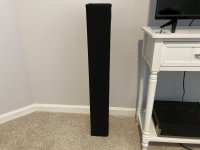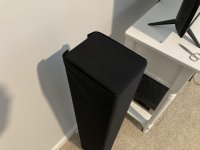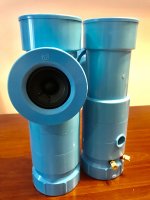I never bother with taking measurements 1cm from the cone.
It serves no purpose unless you want to see a pretty graph with a pretty phase curve.
Meaningfull measurements are taken when the speakers are roughly in the spot you will place them, and you are sitting on the chair/couch you will be listening. Place your mic where your head is, and measure.
Taking more than one measurement along the couch will be better if you want more to see what others on the couch will be listening.
Of course, you will get a ragged phase response due to floor, ceiling, furniture, etc, and the FR will also have dips and peaks, not the kind of curve a manufacturer would share, but at least it will be representative of your own room and placement.
With that curve, you adjust the speaker placement, listening position, add filters like BSC, and even EQ if you wish. Anything to get a better enjoyment of music.
Happy listening!
It serves no purpose unless you want to see a pretty graph with a pretty phase curve.
Meaningfull measurements are taken when the speakers are roughly in the spot you will place them, and you are sitting on the chair/couch you will be listening. Place your mic where your head is, and measure.
Taking more than one measurement along the couch will be better if you want more to see what others on the couch will be listening.
Of course, you will get a ragged phase response due to floor, ceiling, furniture, etc, and the FR will also have dips and peaks, not the kind of curve a manufacturer would share, but at least it will be representative of your own room and placement.
With that curve, you adjust the speaker placement, listening position, add filters like BSC, and even EQ if you wish. Anything to get a better enjoyment of music.
Happy listening!
I find very interesting and practical with REW use the generator white random noise and the RTA on, you can have an immediate idea of what is happening at your listening position, in this way is possible to move mic or speaker and see immediately the difference on response for get a good optimal position, mic must pointing the ceiling and of course the right cal file for that position....all the best
Different types of measurements
I think a good starting point to understanding of different types of measurements one could (and should) perform is this classic book: Testing Loudspeakers: Joseph D'Appolito: 9781882580170: Amazon.com: Books
The curves you get in your listening spot include all the reflections (including your couch and even your body). Try to stand on one side of the mic and then on the other, and you get two different curves. These measurement, as correctly stated, are very much necessary if you are using a DSP, adjusting absorption and diffusion of the room, or simply adjusting the position of the speaker, which you already have.
However, for designing the speaker to be as flat as possible, or to have a certain target response, you need an unechoic data, which measure the speaker only. Unless you have access to an unechoic chamber with 10 meters of absorption on every wall, including floor and ceiling, your far field curves will only be unechoic down to 200 - 300 Hz. Most manufacturers of the drivers publish these curves and then splice the theoretical, calculated curve below that. The only way I know of getting the real bottom portion of this curve, is to perform the "near-filed" measurement. When the mic is 1 cm from the cone, the sound from the driver is so much louder than the reflections, that the reflections are not affecting the output. Ditto for any kind of port your speaker has, or a passive radiator. The nearfield data however are totally useless above the first cone break-up, so use lower frequencies only. Then you can splice the nearfield data to the far field data, and you can see what kind of speaker you've build. Then depending on where you have placed the speaker, you can start the other adjustments. What if you had to move the speakers to another room, another house, or even part with them?
VadimB
I think a good starting point to understanding of different types of measurements one could (and should) perform is this classic book: Testing Loudspeakers: Joseph D'Appolito: 9781882580170: Amazon.com: Books
The curves you get in your listening spot include all the reflections (including your couch and even your body). Try to stand on one side of the mic and then on the other, and you get two different curves. These measurement, as correctly stated, are very much necessary if you are using a DSP, adjusting absorption and diffusion of the room, or simply adjusting the position of the speaker, which you already have.
However, for designing the speaker to be as flat as possible, or to have a certain target response, you need an unechoic data, which measure the speaker only. Unless you have access to an unechoic chamber with 10 meters of absorption on every wall, including floor and ceiling, your far field curves will only be unechoic down to 200 - 300 Hz. Most manufacturers of the drivers publish these curves and then splice the theoretical, calculated curve below that. The only way I know of getting the real bottom portion of this curve, is to perform the "near-filed" measurement. When the mic is 1 cm from the cone, the sound from the driver is so much louder than the reflections, that the reflections are not affecting the output. Ditto for any kind of port your speaker has, or a passive radiator. The nearfield data however are totally useless above the first cone break-up, so use lower frequencies only. Then you can splice the nearfield data to the far field data, and you can see what kind of speaker you've build. Then depending on where you have placed the speaker, you can start the other adjustments. What if you had to move the speakers to another room, another house, or even part with them?
VadimB
I think I passed the finish line on this build. My last bit of tinkering was adding the BSC, filling in the Faital Pro frame with silicone, and wrapping 3/4+ of the speaker in fabric. Again, many calamities occurred, including me sticking my thumb right into the dust cap. It's amazing how much abuse drivers can take. I picked the hardest way to install the BSC. I wish I did it when building cabinet. The fabric fold at the top of the speaker sucks--it is what it is.
Attachments
So there is a raised rim around the edge of the driver frame. When building, I had to recess the driver so the rim was flush. I took silicone and filled in the channel around the rubber gasket and the channel between the driver frame and the cabinet. Now there is a smooth 45 degree (kind of) slope between the driver gasket to the cabinet. The theory is that smooth transition eliminates baffle step issues. I realize this is a bit obsessive. I would take a picture, but the fabric is in place and it takes a ton of messing around to get the fabric to sit correctly when only held in place via tension between glaziers points.
You could leave the BSC outside the cabinet.
I know. I am a masochist and it looks so pretty.
Thanks for the details. Maybe obsessive, but it is a good idea. Even if it does not make a noticeable difference in the sound, at least you sleep better. I am busy with my TABAQ's using 4FE32 drivers and might even do the same. I was also thinking of actually removing the rubber gasket, since it serves no purpose mounted with the back against the baffle.So there is a raised rim around the edge of the driver frame. When building, I had to recess the driver so the rim was flush. I took silicone and filled in the channel around the rubber gasket and the channel between the driver frame and the cabinet. Now there is a smooth 45 degree (kind of) slope between the driver gasket to the cabinet. The theory is that smooth transition eliminates baffle step issues. I realize this is a bit obsessive. I would take a picture, but the fabric is in place and it takes a ton of messing around to get the fabric to sit correctly when only held in place via tension between glaziers points.
Last edited:
I've been playing with 3FE25 in a "bookshelf" speaker made from 100mm dia uPVC pipes and want to add a longer pipe. Tabaq is what came to mind.
If I invert the enclosure the driver would then sits about the right distance from the top (20 and a bit cms) and then with pipe added to the bottom I can then get them about the right height above the port.
Question: the cross section area is going to be ~76cm2 rather than the ~128cm2 in the box plan. Thus, volume will be less.
Is it the volume or the length of the TL that is more critical?
I realise that I am never going to get to the ideal using the pipes but it is what I have to hand for the moment.
If I invert the enclosure the driver would then sits about the right distance from the top (20 and a bit cms) and then with pipe added to the bottom I can then get them about the right height above the port.
Question: the cross section area is going to be ~76cm2 rather than the ~128cm2 in the box plan. Thus, volume will be less.
Is it the volume or the length of the TL that is more critical?
I realise that I am never going to get to the ideal using the pipes but it is what I have to hand for the moment.
Attachments
I am busy with my TABAQ's using 4FE32 drivers and might even do the same. I was also thinking of actually removing the rubber gasket, since it serves no purpose mounted with the back against the baffle.
Yes, the gasket is only useful when mounting internally. I thought about doing the same. But I got scared that I would damage the surround when removing it.
I've been playing with 3FE25 in a "bookshelf" speaker made from 100mm dia uPVC pipes and want to add a longer pipe. Tabaq is what came to mind.
If I invert the enclosure the driver would then sits about the right distance from the top (20 and a bit cms) and then with pipe added to the bottom I can then get them about the right height above the port.
Question: the cross section area is going to be ~76cm2 rather than the ~128cm2 in the box plan. Thus, volume will be less.
Is it the volume or the length of the TL that is more critical?
I realise that I am never going to get to the ideal using the pipes but it is what I have to hand for the moment.
Enclosure to port area ratio in Tabaq. 128cm2:16cm2 in Tabaq. I guess if you can keep the ratio of enclosure area to port area similar, it should come out somewhere near. If not you'd need to fiddle with the port length. Or model it in LA or Hornresp.
Your CSA is almost half of what is needed for the TABAQ. And you don't mention the length, but in that picture , it seems much less than 80cm.
A little off the numbers in the plans will not affect too much, but halving them will certainly do!
A little off the numbers in the plans will not affect too much, but halving them will certainly do!
I've been playing with 3FE25 in a "bookshelf" speaker made from 100mm dia uPVC pipes and want to add a longer pipe. Tabaq is what came to mind.
If I invert the enclosure the driver would then sits about the right distance from the top (20 and a bit cms) and then with pipe added to the bottom I can then get them about the right height above the port.
Question: the cross section area is going to be ~76cm2 rather than the ~128cm2 in the box plan. Thus, volume will be less.
Is it the volume or the length of the TL that is more critical?
I realise that I am never going to get to the ideal using the pipes but it is what I have to hand for the moment.
I think I passed the finish line on this build. My last bit of tinkering was adding the BSC, filling in the Faital Pro frame with silicone, and wrapping 3/4+ of the speaker in fabric. Again, many calamities occurred, including me sticking my thumb right into the dust cap. It's amazing how much abuse drivers can take. I picked the hardest way to install the BSC. I wish I did it when building cabinet. The fabric fold at the top of the speaker sucks--it is what it is.
Looks like you really love do the hardest way, if you think that the 4FE32, 35 and so on are born to be mounted in car dashboard, then we find is an amazing driver for Tabaq, problem is this ugly mounting frame, so please look around in car part shop and you will found lots of gasket 4 inch size that fit the Faital Pro without the risk of ruin the driver, you are in US so I think you can find it in your local market, I personally had to buy those gasket in Aliexpress because here in Philippines nothing like that is available and if you still can take away that fabric looks very bad to me, sorry if I tell you
Thanks Irishpatrick. I'll also probably do a similar thing to mine when assembling them.
I would caution others. I chose silicone because it could be removed if I needed to remove driver. However, it was a pain to work with (and not get any on driver) and it looks ugly. My plan was to cover speaker in fabric, so that didn’t matter.
Is there a Tabaq for 6 inch driver? I searched the thread. Couldn't find any.
Take a deep breath before looking at the "Wibaq". It's substantial.
- Home
- Loudspeakers
- Full Range
- TABAQ TL for Tangband


